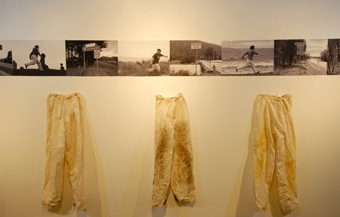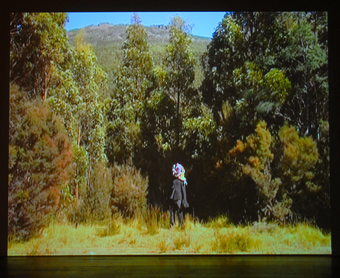an other place – gough & mcquinn: you are going the wrong way
judith abell

Julie Gough, We Ran/I Am
photo Craig Opie
Julie Gough, We Ran/I Am
How do we experience place? How much can we ever understand of a foreign place? If we read the signs will they tell us the story? These are questions that arise in experiencing works by Julie Gough and Austin McQuinn in AN OTHER PLACE.
Julie Gough’s work We ran/I am is composed of a series of black and white photographs matched against pairs of rough-sewn wool and calico trousers. The trousers hang as physical evidence of the photographic content. As the artist is documented running through the horizontally mounted images, the trousers underneath bear different levels of soiling that could reflect falls to the ground or lost footing. A map mounted on the side wall shows the marking of the Black Line, part of a notorious campaign in 1830 by Lieutenant Governor George Arthur involving a moving chain of Tasmanian residents intended to round up all Indigenous islanders, most of whom would eventually die as a result of imprisonment and disease. Interspersed between the active images are stills of the tired signposts welcoming travellers to towns along the Line with the standard claims about being “Historic” or “Tidy”. As an adjunct to her title, Gough quotes a journal entry from George Augustus Robinson: “The people all seemed satisfied at their clothes. Trousers is excellent things and confines the legs so they cannot run.” (sic) In similar trousers, Gough relives the escapes of her ancestors.

Austin McQuinn, Bogeyman
photo Craig Opie
Austin McQuinn, Bogeyman
Austin McQuinn’s work also journeys through a series of places, but with a different kind of energy. Bogeyman is a wall-sized video projection with a five minute loop showing a series of locked shots of Hobart. Coming into the work at a particular point I was confused by the intent as it flicked through a number of shaky views of Hobart backed with questionable sound. Almost to the end of the fifth shot, my patience waning, his Bogeyman appeared. This creature is presumably the artist or a projection of McQuinn, dressed in sagging black knit pants and top, hands and feet encased in what could be mittens. His head is completely covered by a headdress of knitted toys. The figure is both pathetic and absurd as he walks slowly through each of the shots from the top of Mount Wellington to a single cell within the old Hobart Gaol. In what could be the final shot, he disappears under the bed, like the bogeyman of childhood.
Together these works address a condition that I believe is intimate to Tasmanians and visitors—the sense of experiencing, but perhaps not understanding the place you inhabit. Gough’s work reveals a dark layer of Tasmania’s past that makes a parody of the “historic” in the worn out welcome signs within her images. Her Tasmania is definitely “an other place” from the pristine island that we see in the advertisements and its people are to be feared. McQuinn’s figure also reveals an experience of distance from the landscape. I imagine that his moping monster represents the artist’s feeling of isolation as a resident of Ireland attempting to make work in a foreign place, walking blindly through a landscape he may never understand.






